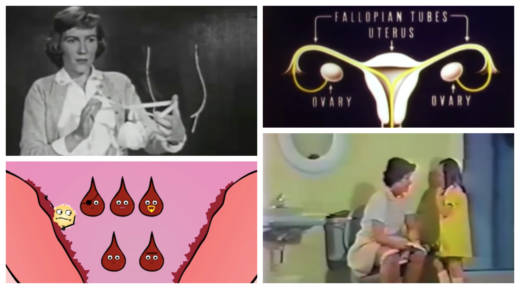1953
This "educational" video winds down with a young girl cheerily telling a friend: "You know I've got the curse!" Before that, we get a wealth of terrible advice from Miss Jensen, a health educator who presents menstruation firmly within the confines of gender roles, not biology, describing it as "the natural, normal process leading up to being a mother."
Other advice here expands on the Disney/Kotex version of period-living where showering in the wrong temperature, slouching and "square dancing" are dangerous. By the end, Miss Jensen's presentation has descended into a sort of mania: "You should be more careful than ever about personal cleanliness, and change your underwear more often, and be sure and use a deodorant, and pay more attention to your hair and your nails, and plan to wear your prettiest dress.” (For a film about periods, Miss Jensen sure doesn't like using them.)
Then mom goes and makes it worse by not knowing anything about basic biology. Asked why periods happen every month, she tells her child, "It's just part of being a woman, I guess." Welcome to the 1950s: You're bleeding and no one will tell you why, but, hey, straighten those backs, ladies!
1967
This clip begins with the notion that "All women have periods," thereby erasing reproductively challenged and trans women from the picture entirely. Fun! Like the 1953 video, this 1967 PSA is absolutely terrified of biologically specific words. "Blood from inside my body comes outside," a mom tells her daughter in a scarily unspecific manner. What's more, vaginas are referred to by three separate people as an "opening between my legs." Surprisingly, that prudishness doesn't extend to the two close-up visuals of a blood-soaked sanitary towel. Take that, blue liquid from commercials!
1974
Amazingly, this "educational" video includes a 15-year-old girl introducing herself by giving her physical measurements ("38-25-36"); Mike from Breaking Bad (no, really) suggesting his date is better at bowling because she just got her period; a creepy mustachioed dude eavesdropping on teenagers; rampant heteronormativity; and the trippiest cartoon about reproduction in history. One bright spot? The first mention of tampons so far! Woo?
"Growing Up and Liking It," 1984
At some point, some genius decided the best way to deliver information about puberty and periods was via an actress who had once played Annie on Broadway and some of her costars. There is random singing, mid-sentence; there are tales about the hard life of a Broadway child star (reach a certain height and get fired!); and there are abundant assumptions that interspersing educational clips with these theater actors somehow makes it more interesting (it doesn't, it just goes on for longer). At least it explains sanitary towel and tampon options though; the other videos make it seem like there's only one of each.
"Always Changing, Always Growing," 1997
Remarkably, this Always Ultra commercial dressed up as a teaching aid is the first to include valuable biological information since the 1946 Disney cartoon. Sadly, this one still treats normal period-related misery as the exception to the rule. When a girl asks if having a period hurts, her teacher lies: "Not while you're actually having it. In fact, many women say they hardly notice their period." (WHO AND WHERE ARE THESE WOMEN?!) Then another teacher comes in and, on the subject of PMS, says, "Personally, I've never experienced mood changes, but some women do." Stop lying to the children, Ms. Dominguez. Just stop lying.
Now
These days, thanks to the wonders of the internet, reliance on the old, clunky educational videos of yore has gone down to such a significant degree, we're now firmly within the realms of both surreality:
And excellent (mostly Florida-based) humor:
We've come a long way, ladies.


